Automated Panel Bending Picks Up Where Lean Leaves Off
October 1, 2012Comments
Growth for this Chicago-area sheetmetal fabricator comes via speedy, flexible and automated panel bending, freeing up a new trio of CNC press brakes to take on heavier-gauge production as well as meeting rising demand for prototype development.
Lean manufacturing at its core simply means eliminating, or at least minimizing, wasteful or non-value-added processes and procedures. On the non-value-added list: Machine setups, a necessary yet wasteful evil. While metalformers can’t eliminate setups altogether, they certainly can minimize the time taken between production runs to set up new jobs.
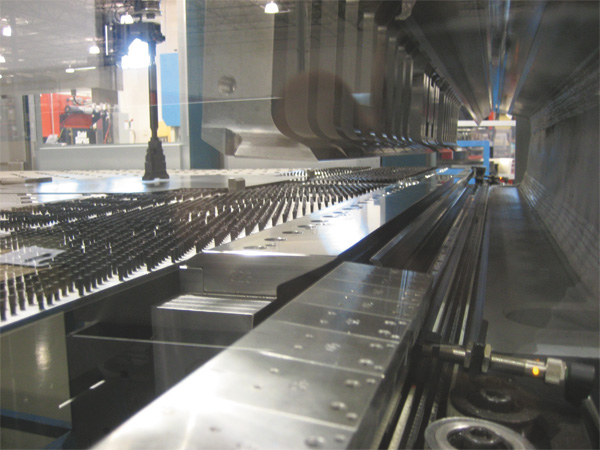 |
| A look down the throat of QFI’s new automated panel bender provides a close-up look at the segmented upper blankholder tooling and lower counterblade tools, as the rotator (top left) mounted to the blank manipulator prepares to place a drawer blank in front of the press. |
At metal fabricator Quality Fabricators Inc. (QFI), Addison, IL, lean has been the name of the game for the last several years, and setup-time reduction has been a key lean initiative. As the firm’s order quantities have shrunk for the sheetmetal enclosures, carts, drawers and similar products it fabricates, its managers and engineers have retaliated by taking steps to slash setup times. We’re talking offline programming of CNC press brakes, real-time bend-angle detection adjustment and other techniques targeted at minimizing operator intervention (wasteful) and optimizing overall equipment effectiveness (value added).
Lean’s Great, But How to Handle Double the Order Quantities?
QFI’s lean focus did wonders for throughput and productivity, but when orders recently increased for one of its key product lines, a fresh look at sheetmetal-forming technology was in order. The job in question for the 124,000-sq.-ft. 100-person shop, which serves the oil processing, medical, military, computer, electronics and other industries: fabrication of enclosures.
“We now make tens of thousands of enclosures annually,” says Victor Camacho, QFI vice president of operations, “a substantial increase in annual volume from just a couple of years ago.” Enclosures are fabricated from 16 to 18 gauge cold-rolled steel or aluminum sheet.
Such growth in sales, while a nice problem to have, challenged the firm’s fabricating capacity. Until recently, the firm fabricated cabinets and enclosures on a manually tooled folding machine, to the tune of 130 to150 per 8-hr. shift.
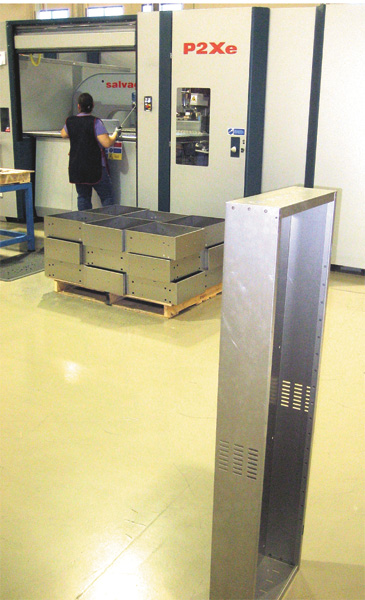 |
| To take advantage of the panel bender’s efficiency and capabilities, QFI engineers have redesigned some of the products it fabricates for customers, including this HVAC enclosure. Tabs were moved from the outside of the part to the inside to allow the part to run on the panel bender. As a result, productivity quadrupled compared to forming the parts on CNC press brakes. |
In Search of a Better Bending Solution
…QFI invested in a new automated panel bender—a P2Xe compact panel bender from Salvagnini. The machine is equipped with an automatic tool changer that enables setup changes to occur in a matter of seconds. That’s brought an entirely new level of flexibility to QFI’s production scheduling.
“Compared to forming the enclosures on our old folding machine, cycle time and throughput have improved dramatically,” notes Tony Mautone, QFI vice president of manufacturing. “We’re able to form 400 units per shift, and with the typical lot size averaging 50 to 100, quick changeover becomes important. The automatic tool changer accomplishes that goal.”
Mautone cites a few key features of the new panel bender that allow it to more than double throughput. First, when the operator loads a blank into the machine, it’s centered just once, at the start of the bending cycle—there’s no need to re-center the blank after each bend. Also, the design of the segmented bending tool is such that the blankholder conforms automatically and instantly to the part dimensions. The blankholder can expand or contract in 0.020-in. increments to accommodate a wide range of bend dimensions.
If you’ve never seen an automatic panel bender run through its paces, the nimble, fast and accurate machines are quite a sight to see. The automatic manipulator grips the blank and quickly indexes it on a horizontal plane in and out of the bend tooling. A rotator turns the blank to present each edge of the part to the tooling, to enable rapid-fire forming up or down. Control capabilities of the rotator include adjustable gripping pressure, so as to not mar the surface finish of the workpiece—particularly important when QFI runs aluminum sheet through the bender. Maximum bend length on the P2Xe is 86 in., yet the compact machine occupies a compact footprint measuring only 19.7 by 9.8 ft.
Don’t Blink—ROI Comes Quickly
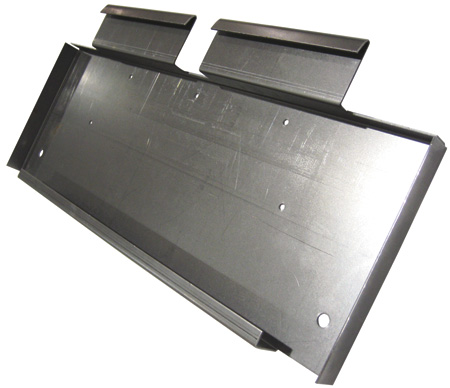 |
| The panel bender forms this part—10 by 20 in.—at a rate of 400 per 8-hr. shift, compared to 200 per shift using two separate setups on a press brake. The second setup was required to hem the hangers, easily tackled by the panel bender. |
“The machine makes all 11 bends without manual intervention, in 33 sec.,” says forming supervisor Bill Altman, adding that total cycle time of a typical enclosure is 52 sec. when accounting for blank load and part unload. “And, the ability to change the length of the tooling segments in a matter of seconds means we can change over the machine from one enclosure style to another faster than the operator can call up the new bend program on the CNC.“
With the P2Xe in production at QFI since January 2012, Altman has been able to move some 85 different jobs over from its press brakes and folding machine, including the various enclosures that consume about 50 percent of its capacity over two daily shifts. Overall, the machine is running at about 90 percent capacity.
“Yes, a second panel bender could be on the horizon if orders continue to climb for our products, or if we’re able to attract other thin-gauge sheetmetal-forming work that fits well with the panel bender’s capabilities,” says Mautone. The bender does have certain limitations, including a maximum bend height of 63⁄4 in., and a minimum edge dimension of 11 in.
“While we can’t form very small parts on it,” says Mautone, “the large number of part numbers that we have been able to move over to the bender from our press brakes has freed up hours upon hours of press-brake capacity to allow us to take on additional heavier-gauge forming. And we’ve even been able to redesign some of the products for our customers, to take advantage of the panel bender’s efficiency and capabilities.
“We’ve had a very strong year in terms of bringing in prototype and production work involving 10-gauge sheet,” Mautone continues, “that fits right into the sweet spot of our three newest CNC press brakes (a 10-ft. 143-ton model and two 8-ft. 88-ton models). Compared to 2009-2010, I’d say our level of prototype development on heavier-gauge sheet is up by 30 percent. And of those development projects, 25 percent have turned into new production jobs, with several projects still out there.”
When asked to account for the redistribution of equipment capacity and the gain in panel-bending throughput to calculate a return on investment for QFI’s automated panel bender, Camacho comes up with an impressive 24 to 28 months. MFView Glossary of Metalforming Terms
See also: Salvagnini America, Inc.
Technologies: Bending, Fabrication
Comments
Must be logged in to post a comment. Sign in or Create an Account
There are no comments posted.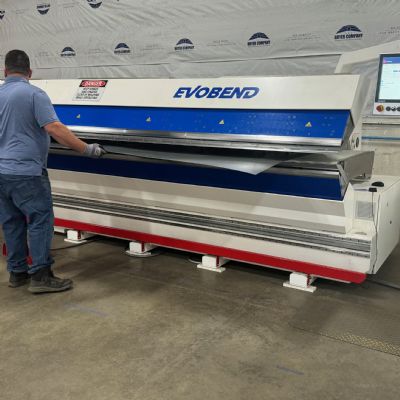 Bending
BendingEnergy-Efficient Double Folder a ‘Game Changer’ for The Brye...
Thursday, September 5, 2024
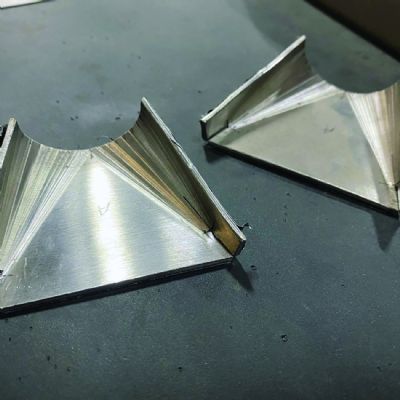 Bending
BendingCreative Approaches to Common Press Brake Challenges, Part 1...
Justin Talianek Tuesday, April 30, 2024
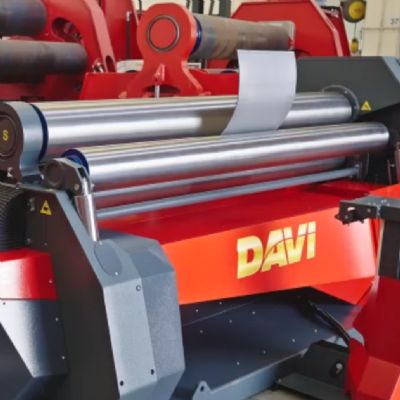 Bending
BendingEnergy-Saving All-Electric Rolling Machine Boasts Speed, Acc...
Wednesday, March 20, 2024






